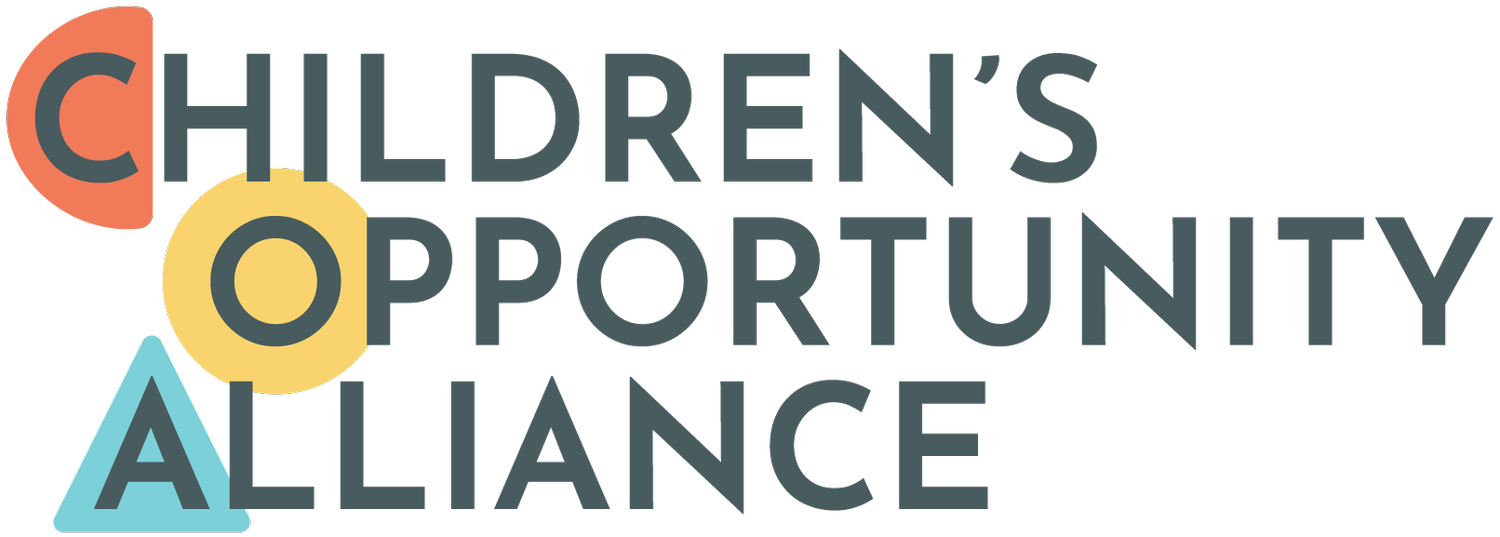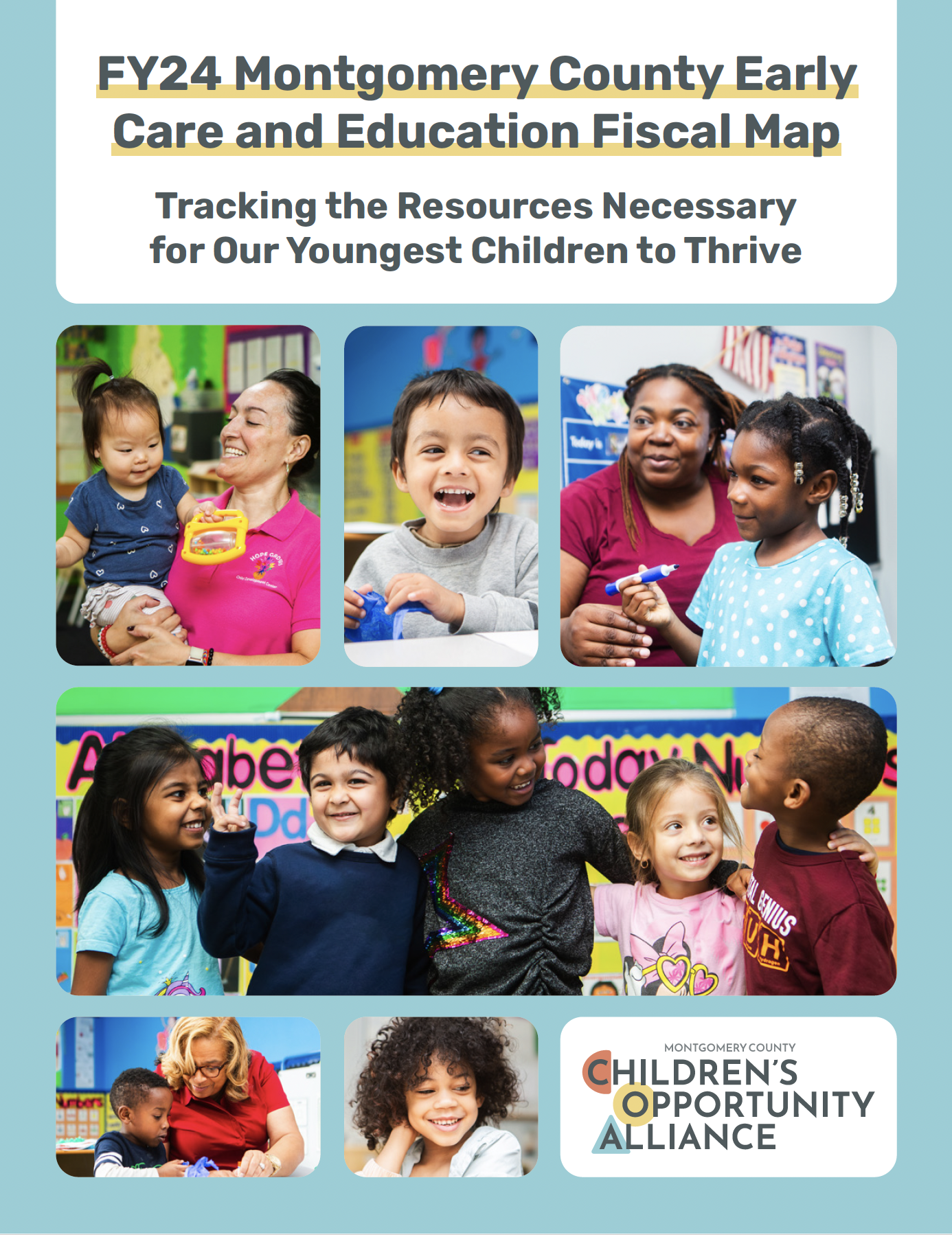FY24 Montgomery County Early Care and Education Fiscal Map
Tracking the Resources Necessary for Our Youngest Children to Thrive
-
Changes in the Level of Public and Private Investment Montgomery County Early Care and Education (FY22-FY24)
Building on the baseline set in the Fiscal Year (FY) 2022 - FY23 Montgomery County early care and education (ECE) fiscal map, analysis of FY24 fiscal data continues to confirm the need for greater investment in our County’s youngest children. This fiscal map report, which tracks investments in the system against the strategies of the Montgomery County Early Care and Education Common Agenda, paints a picture of the system that has begun to stabilize and grow post-pandemic. In FY24, several promising innovations were at various stages of launch; more children, families, and educators participated in public safety-net programs and ECE quality and credentialing achievement bonuses; and demand for services such as special education and parenting resources continued to increase. Despite substantial investments and efforts, many young children were not able to access the resources and supports they needed to thrive. The fact remains that the ECE system is built on an unsustainable economic model that places the burden primarily on families in the form of unaffordable tuition and the ECE workforce in the form of low compensation.
Fiscal Map Snapshot
In FY24, identified public and private spending totaled nearly $340M annually, a growth of 28% from FY22. The majority of money in the system is federal funding, even as pandemic relief funds ended. County funds are represented in both the MCPS and the DHHS agency funding. Identified philanthropy has fluctuated, yet it remains less than 1% of total investment.
Key Fiscal Map Findings
Growth of direct income assistance supports: Safety net programs such as SNAP, WIC, and Child Care Scholarship grew substantially in the three-year period between FY22 and FY24. As the economy shifts and funding is potentially cut, we need to pay attention to the impacts on overall family budgets.
Sustaining local innovation: In FY24, Montgomery County introduced many innovations and updates to supports in the early childhood system, which show promise and will require reliable and expanded funding to be sustained and scaled.
Growth of demand for special education services: Demand for early intervention and special education continues to grow post-pandemic, as does the funding for associated programs, costing nearly $75M in FY24. Funding for aligned services such as mental health supports and behavioral needs training for educators must also grow. Early intervention has a high return on investment. It is critical that funding in this area adequately meets the growing demand.
Reach of access and affordability funding: Over $200M was spent on efforts to increase access and reduce family costs, but only one-third of children in income-eligible families received supports to access early care and education.
Inadequate investments in the ECE workforce: ECE educators are the backbone of quality early care and education; yet the workforce suffers from inadequate compensation, causing high turnover and continued workforce shortages. Fewer than $5M of investments that support the workforce were identified, mostly around training new educators. More financial investment in compensation and credentials is needed to stabilize the field.
Limited provider participation in public grants: Fewer than 3% of the more than 1,200 ECE providers in Montgomery County accessed available public grant programs; these programs are effective but limited in scale. Greater outreach, technical assistance, and funding are needed to expand participation.
Overall County investment in children 0 - 5: Identified investments in Montgomery County’s operating budget grew from $128M (FY22) to $158M (FY23), but the overall budget also grew (from $5.9B to $6.8B), leaving the share of the County budget for children under 5 stagnant at ~2%, though this group represents 7% of the population.
FY22 - FY24 Fiscal Investments by Common Agenda Strategies
This fiscal map is framed by the four Common Agenda strategies: Expanding access and affordability, improving family navigation, advancing the ECE workforce, and advocating for system change and funding. These show how our collective work has — and can continue to have — the greatest impact on the youngest children and their families in Montgomery County. The Montgomery County ECE Common Agenda seeks to ensure all children arrive to Kindergarten ready to learn and thrive and focuses on shared work for five years, from 2025 to 2030. As evidenced by the figure on the next page, the largest public and private investments support expanding access and affordability. The next-largest investments are in the overall health and well-being of children ages 0 - 5 and their families, represented by the “other” category. The remaining three strategies — family navigation, systems change and advocacy, and supports for the ECE workforce — follow.
FY24 Fiscal Map Findings
Key findings from our latest fiscal map include:
▶ GROWTH OF DIRECT INCOME ASSISTANCE SUPPORTS TO INDIVIDUALS
Participation in and expenditures for state and federal public assistance programs expanded significantly between FY22 and FY24, helping many families, educators, and child care programs and businesses. This includes:
SNAP grew 92% from ~$26M to ~$49M
WIC grew 29% from ~$26M to ~$33M
CCS grew 208% from ~$18M to ~$54M
Child Care Credential Program achievement bonuses grew 85% from ~$396K to ~$700K
As the federal spending climate shifts and the state budget shortfall looms, changes to these programs could have significant impacts on families already struggling financially. This will impact what families are able to afford and access in terms of child care. We need to be prepared for the impact of potential changes to family budgets and identify strategic interventions so that children do not suffer.
▶ SUSTAINING LOCAL INNOVATION
During times of more readily available funding, Montgomery County used local funding to usher in many innovations and updates in early care and education. Examples of innovations include a new online portal to apply for local subsidy programs, a new grant program to fund outreach to families with young children to connect to SNAP nutrition assistance, and feasibility studies to launch new systems-level supports to improve the sustainability of child care businesses.
These new programs and initiatives are just beginning to show positive impacts at a small scale and/or are gearing up to launch in future fiscal years and anticipate positive impact. All of these new programs will require continued reliable funding to be sustained and additional funding to be scaled to serve more eligible children and families.
▶ GROWTH OF DEMAND FOR SPECIAL EDUCATION SERVICES
Demand for early intervention and special education continues to grow post-pandemic, and it continues to be the most expensive service in the early childhood system, costing nearly $75M in FY24 to serve 6,599 young children in the Infants and Toddlers Program, Preschool Education Program, and Child Find program. Federal and state laws require that all students with disabilities are provided a free, appropriate public education, meaning that the state and County must pay for services for all young children identified as eligible for services. Research has shown that intervening early saves the system money in the long term. New programs to support mental health needs are growing and have big demand, such as the Infant and Early Childhood Mental Health Consultation, but funding is not mandated nor guaranteed. Students with disabilities demonstrate readiness for MCPS Kindergarten at much lower rates than their peers who meet typical developmental milestones (17% as compared to 50%). Early childhood educators increasingly voice a need for enhanced training and support services to ensure the success of children with additional behavioral challenges in community-based settings. It’s critical that funding in this arena is adequate to serve the growing demand and doesn’t necessitate reductions in other vital services.
▶ REACH OF ACCESS AND AFFORDABILITY FUNDING
Across our strategic priorities, the most funding is invested to improve access to early care and education programs by reducing costs for families — over $200M — yet only one-third of income-eligible children are being served. It will take significant changes to triple our investment in improving access.
| Strategy Area | FY24 Identified Funding |
|---|---|
| Access and Affordability | $203,754,584 |
| Family Navigation | $14,387,596 |
| ECE Workforce | $4,185,930 |
| Systems Change and Advocacy | $5,810,922 |
| Other | $111,957,421 |
20,000+
55% of children in the County live in families with an income that meets the eligibility requirements for child care subsidy programs, yet only 35% receive subsidized care, leaving over 20,000 young children without tuition support for ECE.
▶ INADEQUATE INVESTMENTS IN THE ECE WORKFORCE
The reimbursement rates for tuition subsidy programs are typically set at market rate, as opposed to the true cost of quality care (with the notable exception of the new local innovative EquiCare Subsidy Seats Grant Program), leaving child care businesses without the funds to adequately compensate their workforce. Fewer than $5M in funding was identified to fund training and supports for the workforce — most of it in funding for training of new professionals entering the field. Workforce shortages directly impact how many children can be served. Investments need to be made to increase both compensation and competencies through incremental fixes implemented in tandem that adequately and appropriately value the skills and competencies required to educate children well.
▶ LIMITED PARTICIPATION IN PUBLIC GRANTS FOR CHILD CARE PROVIDERS
Across six public grant opportunities available to child care providers (Capital Support, Early Head Start, EquiCare, Pre-K Expansion, Pre-K Capacity Building, and Therapeutic Child Care), there were 35 Montgomery County-based recipients in FY24. There were nearly 1,200 providers in the County at that time (center-based child care and family child care), meaning fewer than 3% of providers received public grants to support their initiatives or reduce tuition for their families. While these grant programs are helpful interventions, their scale needs to grow significantly to provide equitable access across the geographies and communities where vulnerable children are living. There needs to be more outreach and communication efforts to providers to improve awareness, more capacity-building technical assistance to improve ability to apply for grants, and more resources available within the grant funding streams.
▶ OVERALL COUNTY INVESTMENT
Though identified investments in the County’s operating budget that supports children 5 and under grew between FY22 and FY24 (from $128M to $158M), so did the County’s budget overall (from $5.9B to $6.8B), leaving the percentage of money invested stagnant around 2%. Children ages 5 and under represent 7% of the County’s total population. MCPS had a budget of over $3.1B in FY24. Studies show that early childhood education yields a return of four to nine dollars for every dollar invested. It not only presently benefits the health, education, and development of young children and supports parents, but it also leads to increased earnings, employment, and safety in the future. It’s time for Montgomery County to invest more in its youngest residents.


